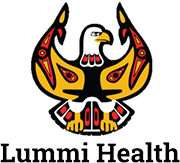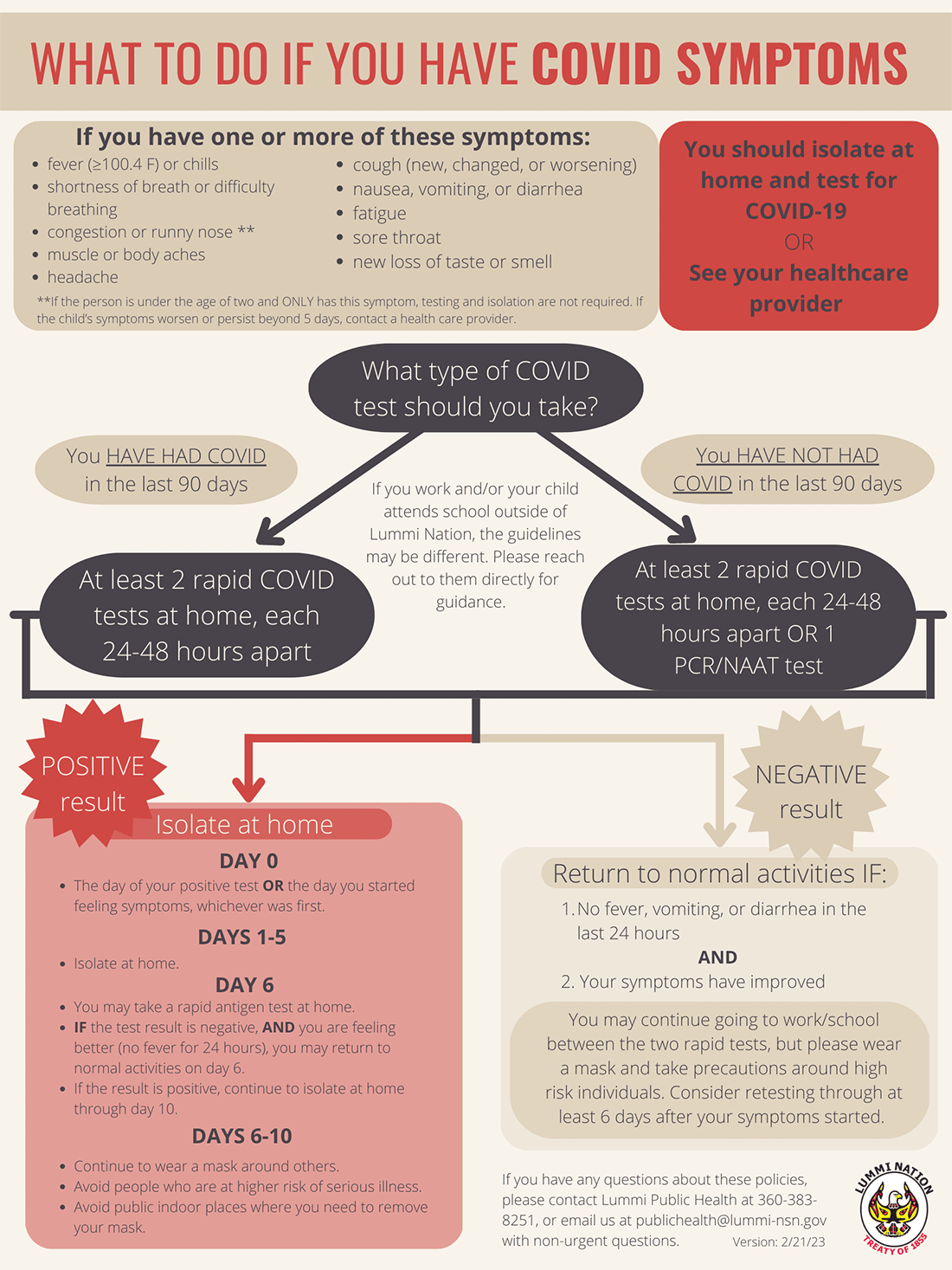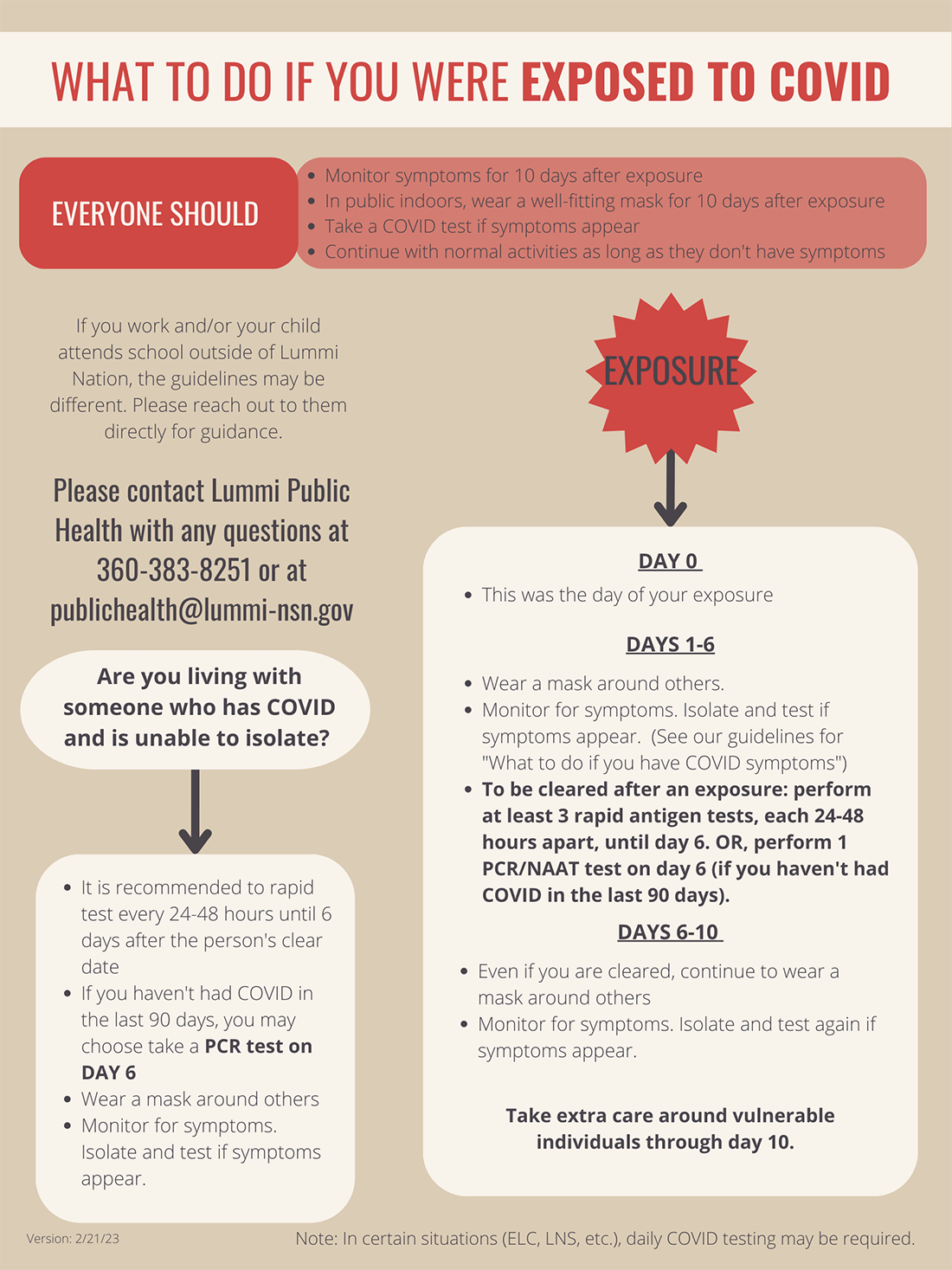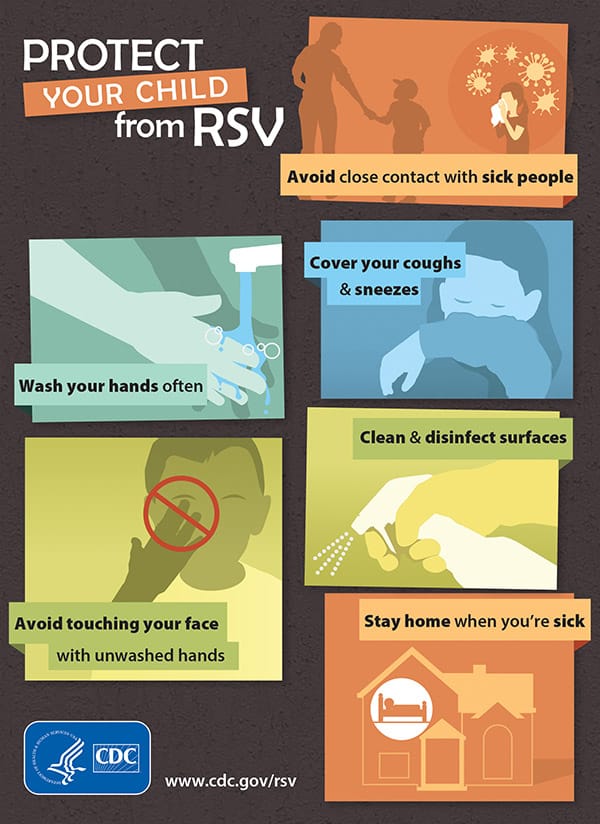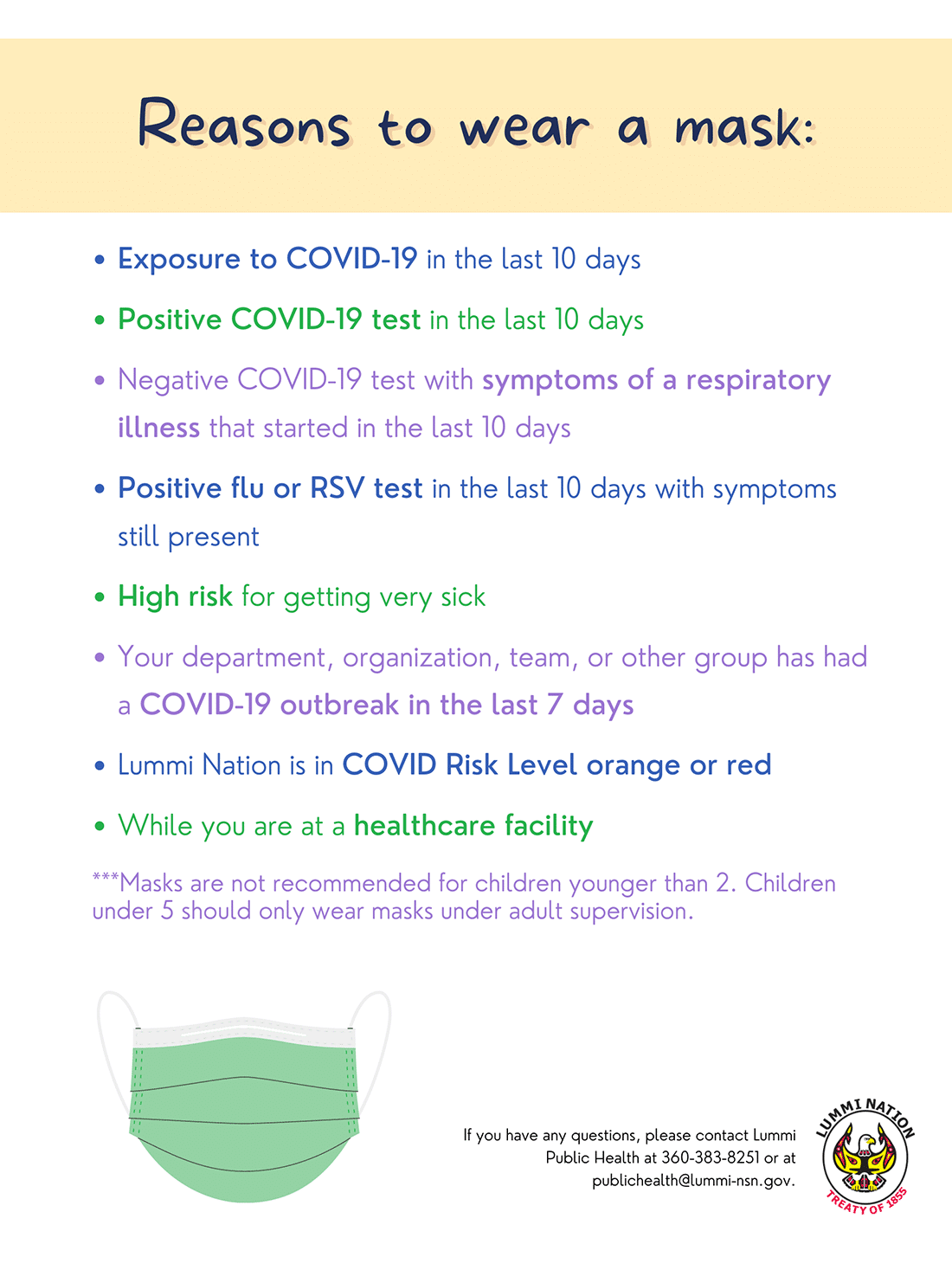COVID-19 & Respiratory Viruses
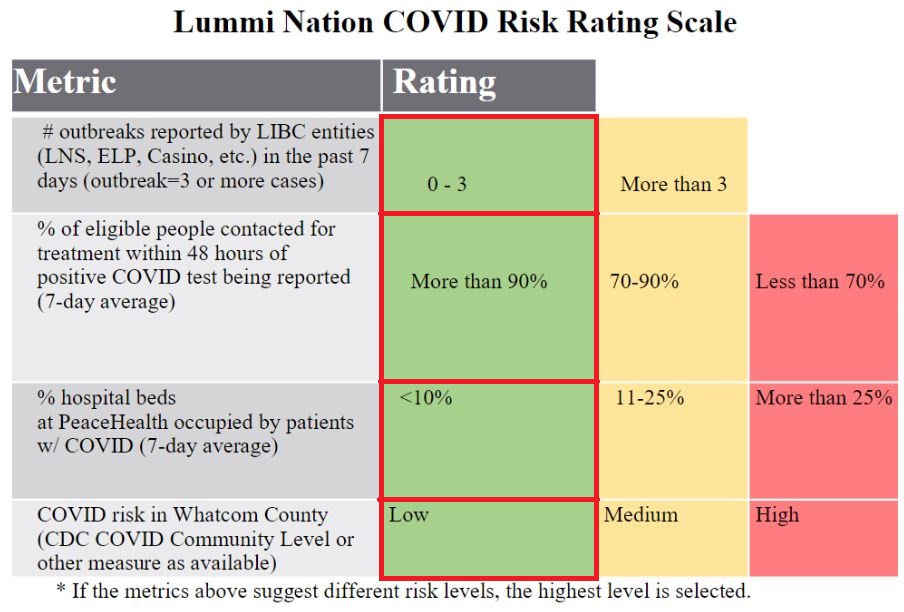
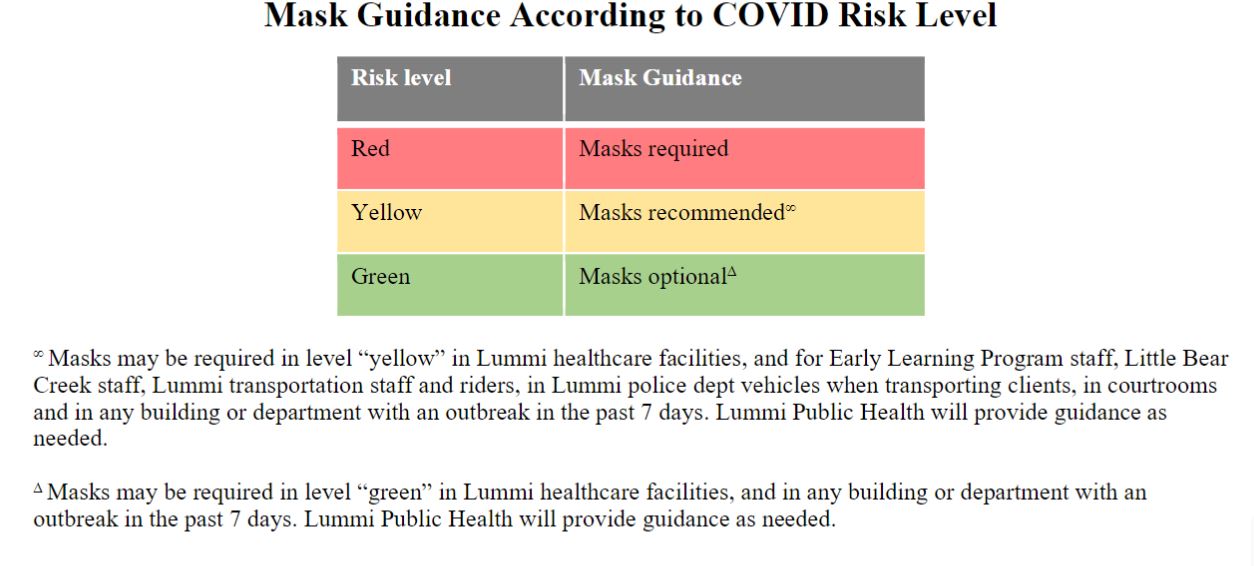
Day 0: The day you tested positive OR the day you started having symptoms, whichever came first.
- If you are eligible for care at Lummi Tribal Health Center, contact the clinic to be evaluated for COVID treatment. If you are not eligible for care at LTHC, contact your primary care provider. Washington State Department of Health also offers free telemedicine treatment for COVID for all residents of the state, click here for more information. (https://doh.wa.gov/emergencies/covid-19/treatments/telehealth#:~:text=Telehealth%20providers%20are%20available%20every,%2D800%2D525%2D0127.)
- COVID treatment might prevent you from getting so sick that you need to go to the hospital and may also reduce the length of your illness.
Days 1-5: Stay home and isolate.
- Stay in a separate room away from people who have not tested positive for COVID.
- Use a separate bathroom if possible. If you have to share a bathroom, wear a mask, leave the fan on all the time (or open a window), close the toilet lid before flushing, and disinfect areas you touched with cleaning wipes.
- If multiple people have COVID at the same time, they can spend time together in the same space.
- Avoid shared spaces in the home. If you have to share a space, everyone should wear a mask and open a window or use an air purifier.
- Do not go into any public places except for urgent medical appointments. Do not visit anyone’s house or any community places. Stay home from work, school, stores, and any other public places. If you are going to a medical appointment, tell them that you have COVID before you arrive and follow their directions to keep patients and staff safe.
Days 6-10: It is strongly recommended to do a rapid antigen test at home on Day 6. Click here (currently lower on this page, please link once on a page) for information on where to get rapid antigen tests.
- If your rapid test is positive on Day 6 OR you had shortness of breath when you were sick, stay home until Day 11. Continue following the guidance for Days 1-5. After 10 days, you do not need to test again unless you are still not feeling well on Day 10 – if this is the case, please contact your primary care provider for guidance.
- If your rapid test is negative on Day 6 OR if you don’t do a test but your symptoms are better AND you did not have shortness of breath when you were sick AND you are not immunocompromised AND you have not had a fever in the last 24 hours, you may return to work/school on Day 6. Please wear a well-fitting mask through the end of Day 10 while you are around other people.
If you have a weakened immune system or if you had to be hospitalized for COVID, you may need to isolate for longer than 10 days; please contact your primary care provider for guidance.
Please contact your employer, school, or childcare about specific guidance on when you can return to work/school/childcare (for example, healthcare workers have different return to work guidelines).
Care Connect is available to provide food, housing, and financial resources for people who recently tested positive for COVID. To learn more, call the WA State COVID Information Hotline at 1-800-525-0127 and press #. Hours are 6 AM to 10 PM (Monday) and 6 AM to 6 PM (Tuesday-Sunday and observed state holidays).
If you develop one or more of these symptoms that isn’t explained by a chronic medical condition:
- Fever (100.4 F or higher) or chills,
- Shortness of breath or trouble breathing,
- Congestion or runny nose,
- Headache,
- Muscle or body aches,
- Cough (new, changed, or worsening),
- Nausea, vomiting, or diarrhea,
- Fatigue,
- Sore throat,
- New loss of smell or taste,
You should stay home and test for COVID-19 (see below).
If you have been exposed but you are not having symptoms:
- If you have had COVID in the past 30 days and are not having symptoms, you do not need to test.
- If you have not had COVID in the past 30 days, test on the first day after exposure and then continue testing on Day 5 (or sooner if you develop symptoms) based on the guidelines below:
- If you have not had COVID in the past 90 days: perform 1 PCR/NAAT test OR at least 3 home rapid antigen tests, each 24-48 hours apart.
- If you have had COVID in the past 31-90 days: perform at least 3 home rapid antigen tests, each 24-48 hours apart.
- Even if the tests are negative, wear a mask* and take extra precautions around people who could get very sick from COVID for 10 days after exposure.
- You do not need to isolate/quarantine if all your COVID tests are negative and you are not having symptoms.
- If you are living with someone who is COVID positive and you are unable to isolate (for example, if you are caring for a young child), take a rapid test every 24-48 hours until 6 days after the person has been cleared.
CDC Guidance for exposures: https://www.cdc.gov/coronavirus/2019-ncov/your-health/if-you-were-exposed.html
*Masks are only recommended for people over the age of 2 (with adult supervision for ages 2-4) and are not recommended if a medical condition prevents them from safely wearing a mask
Additional Information:
CDC: https://www.cdc.gov/coronavirus/2019-ncov/symptoms-testing/testing.html
WA DOH: https://doh.wa.gov/emergencies/covid-19/testing-covid-19
Where Can I Get More Home COVID Tests?
- Washington State Department of Health: https://sayyescovidhometest.org/
- US Government: https://www.covid.gov/tests
- Lummi Tribal Health Center
About the Flu and RSV:
Flu (Influenza) and RSV (Respiratory Syncytial Virus) often spread in the Fall and Winter. To protect yourself and others, wash your hands often, avoid touching your face, avoid close contact with sick individuals, and wear a mask in public indoor settings if you are at higher risk of illness or are having symptoms and can safely do so.
Symptoms of the flu can include fever (or feeling feverish/chills), cough, sore throat, runny or stuffy nose, muscle or body aches, headaches, and/or fatigue (tiredness). Some people may have vomiting and diarrhea.
Symptoms of RSV infection usually include runny nose, decrease in appetite, coughing, sneezing, fever, and/or wheezing. These symptoms usually appear in stages and not all at once. In very young infants with RSV, the only symptoms may be irritability, decreased activity, and breathing difficulties.
If you test positive for Flu or RSV:
If you test positive for flu or RSV, please stay home until you are free of fever and vomiting for 24 hours. Please wear a mask in public settings until your symptoms are gone.
Even if you test negative for these viruses, please wear a mask around others if it is safe for you to do so until your symptoms are gone — there are a lot of other viruses out there that can cause illness.
Wearing a mask can protect you and others around you from COVID, flu, RSV, and other respiratory illnesses.
For a mask to do its job, it must fit tightly on your face and filter the air you breathe. A good fit depends on the size and shape of your face. Air should not be able to move around the edges of your mask.
N95 and KN95 masks provide a better seal and are better at filtering than cloth or medical masks. N95, KN95, and medical masks are available at Lummi Tribal Health Center.

